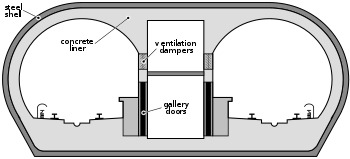Oakland Wye
The Oakland Wye is an underground rapid transit flying wye junction in downtown Oakland, California which serves the Bay Area Rapid Transit (BART) system. Trains can switch between (a) the northbound Richmond or Pittsburg/Bay Point lines (first station: 12th Street/Oakland City Center, underground), (b) the westbound San Francisco lines (first station: West Oakland, elevated), and (c) the southbound Fremont or Dublin/Pleasanton lines (first station: Lake Merritt, underground).[1][2][3][4]:45–46 The Oakland Wye is the center of the BART system, and is a speed bottleneck for the whole system because the vast majority of BART trains pass through it.[1][5]
Oakland Wye | ||||||||||||||||||||||||||||||||||||||||||||||||||||||||||||
|---|---|---|---|---|---|---|---|---|---|---|---|---|---|---|---|---|---|---|---|---|---|---|---|---|---|---|---|---|---|---|---|---|---|---|---|---|---|---|---|---|---|---|---|---|---|---|---|---|---|---|---|---|---|---|---|---|---|---|---|---|
| ||||||||||||||||||||||||||||||||||||||||||||||||||||||||||||
Design
.svg.png)
The original operating speed through most of the Oakland Wye was intended to be 27 mi/h (43 km/h). Design problems led BART operations to impose a 18 mi/h (29 km/h) administrative speed limit on most tracks. Although the design has since been corrected, the speed restrictions remain as a cautionary measure.[1] The track turning north from West Oakland station through 12th Street/Oakland City Center is the only track with a higher operating speed of 36 mi/h (58 km/h) through the Wye.[1]
Bypasses that would connect MacArthur and Oakland Coliseum with the Transbay Tube directly have been proposed to create express service, avoid systemwide delays if glitches occur in the Wye, and potentially provide an infill station at Jack London Square.[6] Other infill stations or more frequent service may be provided in urban core areas if a turnback is built in the Oakland Wye.[7]
History
Incidents
In February 2000, automatic train controls failed due to an electrical short, and trains proceeding through the Oakland Wye were forced to operate in manual and slow to 5–10 mi/h (8.0–16.1 km/h) when switching tracks. Crews were dispatched to manually switch trains between tracks in the Wye, resulting in long delays during the morning commute.[8]
In February 2009, two northbound trains from West Oakland and Lake Merritt sideswiped in the Wye while heading north towards 12th Street/Oakland City Center. Both trains partially derailed. The automatic train control system should have prevented the collision, but one train was operating in manual mode.[9] After the trains were cleared from the tracks early the next day, BART released a statement noting the train operating in manual had proceeded past a wait point,[10] and the NTSB provided an investigator to assist.[11]
In January 2017, a westbound ten-car train arriving at West Oakland stopped partially outside the station, with only the first seven cars on the platform. The resulting backup delayed all train traffic entering the Transbay Tube from the East Bay, and forced commuters to take alternative means to their jobs, including ferries, buses, and ridesharing services.[12]
References
- "BART Sustainable Communities Operations Analysis" (PDF). Bay Area Rapid Transit. June 1, 2013. Retrieved July 31, 2017.
- Mallett, Zakhary (September 7, 2014). "2nd Transbay Tube needed to help keep BART on track". San Francisco Chronicle. Retrieved July 31, 2017.
- Eric (July 23, 2008). "New Feature: BART Track Map". Transbay Blog. Retrieved July 31, 2017.
- "Automatic Train Control in Rapid Rail Transit" (PDF). Office of Technology Assessment. May 1, 1976. Retrieved June 14, 2017.
- "crawl speed through the Oakland Wye tunnels..." BART Rage. November 19, 2007. Archived from the original on August 1, 2017. Retrieved July 31, 2017.
- Cabanatuan, Michael (30 January 2001). "Building a bigger, better BART / Experts suggest improving the current system before extending it". San Francisco Chronicle. Retrieved 9 December 2017.
- Cotey, Angela (July 2012). "Bay Area Rapid Transit's push to invest in state of good repair, capacity improvements". Progressive Railroading. Retrieved 11 December 2017.
- Cabanatuan, Michael (11 February 2000). "Improperly Fastened Power Cable Blamed for Horrendous BART Delay". San Francisco Chronicle. Retrieved 9 December 2017.
- Cabanatuan, Michael (4 February 2009). "BART trains on time, crash site to be cleared". San Francisco Chronicle. Retrieved 9 December 2017.
- Cabanatuan, Michael (5 February 2009). "BART operator ran past wait point in collision". San Francisco Chronicle. Retrieved 9 December 2017.
- "NTSB Launches Investigator to Bart Collision" (Press release). National Transportation Safety Board. 4 February 2017. Retrieved 9 December 2017.
- Cabanatuan, Michael; Veklerov, Kimberly; Ravani, Sarah (6 January 2017). "BART systemwide meltdown after train gets stuck in West Oakland". San Francisco Chronicle. Retrieved 9 December 2017.
